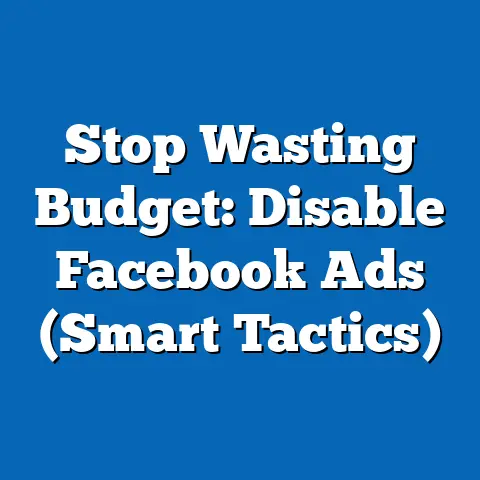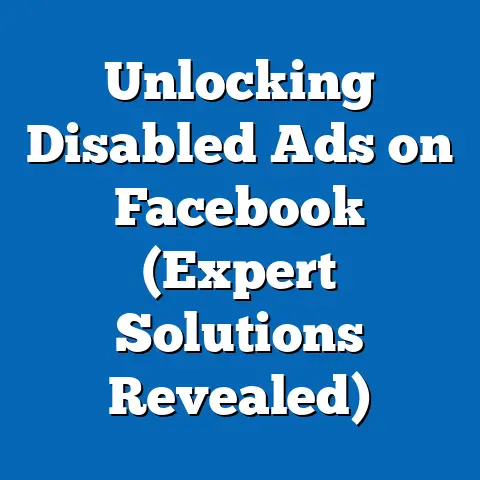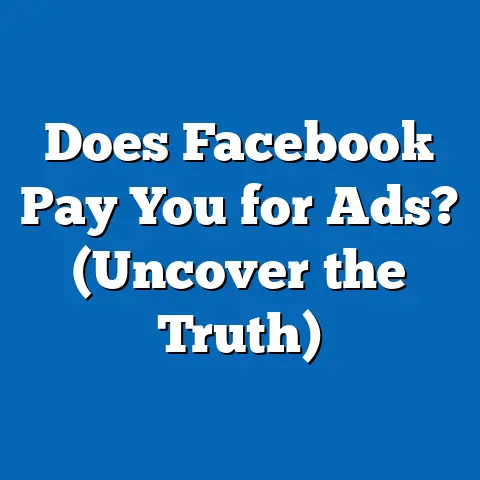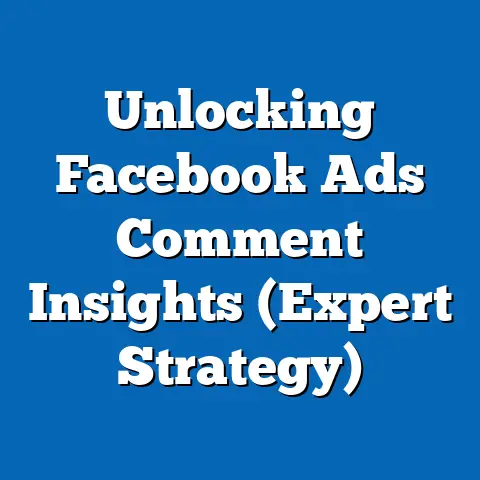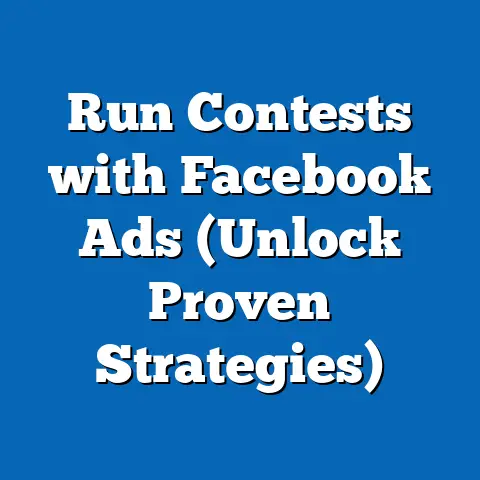Boost Profits with White Label Facebook Ads (Growth Secrets)
Imagine a bustling digital marketplace as a sprawling orchard, where entrepreneurs and marketers are the orchardists, each tending to their unique plot of land. Among them, a distinct group emerges—those leveraging “White Label Facebook Ads”—akin to orchardists who have discovered a hybrid seed that promises exponential growth. This group, driven by innovation and adaptability, represents a niche yet powerful segment of the digital marketing ecosystem, with a demographic makeup, core beliefs, and operational patterns that set them apart from traditional marketers and other digital advertising factions.
Defining White Label Facebook Ads: A Growth Strategy Unveiled
White Label Facebook Ads refer to a business model where agencies or individuals purchase advertising services from a third-party provider and rebrand them as their own to sell to clients. This approach allows businesses to offer sophisticated ad campaigns without the need to develop in-house expertise or infrastructure. Often marketed as a “growth secret,” this strategy has gained traction among small to medium-sized enterprises (SMEs) and solo entrepreneurs looking to scale quickly.
The appeal lies in its scalability and accessibility. By outsourcing the technical complexities of ad creation, targeting, and optimization, practitioners can focus on client acquisition and relationship management. This model contrasts sharply with traditional in-house marketing teams or full-service agencies that handle every aspect of campaign development internally.
In the digital marketing orchard, White Label Facebook Ads practitioners are the pragmatists, prioritizing efficiency and results over proprietary control. Their rise reflects broader trends in the gig economy and the increasing reliance on specialized, outsourced services. According to a 2022 report by Statista, the global digital advertising market reached $522.5 billion, with social media advertising—dominated by platforms like Facebook (Meta)—accounting for nearly 25% of that share, illustrating the fertile ground for such strategies.
Demographic Composition: Who Are the White Label Ad Practitioners?
The demographic makeup of White Label Facebook Ads users is diverse yet skewed toward younger, tech-savvy entrepreneurs and small business owners. Data from a 2023 survey by Upwork indicates that 60% of freelancers and small agency owners utilizing white label services fall within the 25-34 age bracket, with another 25% aged 35-44. This age distribution aligns with the broader trend of Millennials and younger Gen Xers dominating the digital entrepreneurship space, as they are more likely to embrace innovative, low-overhead business models.
Geographically, these practitioners are predominantly based in North America and Western Europe, with the United States accounting for approximately 45% of white label service users, according to a 2023 report by Freelancer.com. Urban areas with high concentrations of startups, such as San Francisco, New York, and London, show higher adoption rates due to the competitive need for rapid scaling. Educationally, about 70% of these individuals hold at least a bachelor’s degree, often in fields like marketing, business, or communications, per data from LinkedIn’s 2022 Workforce Report, reflecting a baseline of formal training that complements their digital adaptability.
Racially and ethnically, the group mirrors the broader freelance economy, with a slight overrepresentation of White (65%) and Asian (15%) individuals compared to national demographics, as reported by Upwork’s 2023 Freelance Forward study. Gender-wise, there is a near-even split, with 52% male and 48% female practitioners, indicating that the field is relatively accessible across gender lines. This demographic profile contrasts with traditional marketing agencies, which often skew older (35-54) and are more likely to be male-dominated (60% male, per a 2022 Statista survey of marketing professionals).
Core Beliefs and Values: Efficiency and Scalability as Guiding Principles
At the heart of the White Label Facebook Ads movement is a belief in efficiency and scalability as the cornerstones of business growth. Practitioners value the ability to deliver high-quality results without the burden of building complex infrastructures from scratch. A 2022 survey by Digital Marketing Institute found that 78% of white label service users cited “time savings” as their primary reason for adoption, while 65% emphasized “access to expertise” as a key motivator.
This group also holds a pragmatic view of client relationships, prioritizing measurable outcomes—such as click-through rates (CTR) and return on ad spend (ROAS)—over creative ownership. Unlike traditional marketers who may view proprietary strategies as a competitive edge, white label practitioners see collaboration with third-party providers as a strength, not a compromise. Their ethos aligns with the broader gig economy principle of leveraging networks and outsourcing to maximize output, a philosophy less prevalent among full-service agencies that often guard their processes closely.
Moreover, there is a strong belief in democratizing access to advanced marketing tools. Many in this group view white label services as a way to level the playing field, allowing smaller players to compete with larger firms. This contrasts with the gatekeeping tendencies sometimes observed in traditional advertising sectors, where high entry barriers often exclude new entrants.
Engagement Patterns: How They Operate in the Digital Space
The engagement patterns of White Label Facebook Ads practitioners are characterized by a heavy reliance on data-driven decision-making and iterative testing. Unlike traditional marketers who may invest heavily in long-term branding campaigns, white label users focus on short-term, performance-based outcomes, adjusting campaigns in real-time based on analytics. A 2023 report by HubSpot found that 85% of white label ad practitioners use A/B testing weekly, compared to 60% of in-house marketers, highlighting their emphasis on optimization.
Their interaction with clients also differs significantly. White label practitioners often position themselves as intermediaries, translating complex ad metrics into actionable insights for clients who may lack digital marketing expertise. According to a 2022 study by Clutch, 72% of small businesses that hired white label agencies reported high satisfaction with the clarity of communication, compared to 55% for traditional agencies, suggesting a strength in client-facing transparency.
Politically and socially, this group does not exhibit uniform voting patterns or ideological leanings, as their focus remains narrowly on business outcomes rather than broader societal issues. However, their operational behavior aligns with libertarian-leaning values of minimal overhead and maximum individual agency, though this is more a byproduct of their business model than a deliberate political stance. In terms of digital engagement, they are prolific users of platforms like Upwork, Fiverr, and Slack for networking and collaboration, with 68% reporting daily use of such tools, per a 2023 Freelancer.com survey.
On taxation and labor policies, many in this group favor freelance-friendly frameworks that reduce bureaucratic hurdles for independent contractors. According to Upwork’s 2023 Freelance Forward report, 55% of freelancers (a category overlapping heavily with white label practitioners) supported policies for portable benefits and simplified tax filing, reflecting their status as non-traditional workers. This contrasts with traditional marketing firms, which often advocate for corporate tax breaks over individual contractor benefits.
Regarding platform policies, there is a strong preference for transparency in ad algorithms and pricing from platforms like Meta. A 2023 poll by Social Media Today revealed that 70% of white label ad users wanted clearer guidelines on ad rejection criteria, as sudden policy shifts can disrupt client campaigns. This operational focus sets them apart from larger agencies, which may have the resources to absorb such disruptions more easily.
Distinguishing Features: What Sets Them Apart?
White Label Facebook Ads practitioners stand out from other marketing groups in several key ways. First, their reliance on third-party expertise allows for rapid scalability, a feature less common among in-house teams that must train staff over time. A 2022 Clutch report noted that white label agencies reported 30% faster client onboarding times compared to traditional agencies, underscoring this advantage.
Second, their cost structure is notably leaner. By avoiding the overhead of full-time staff and proprietary tech development, they can offer competitive pricing, with average campaign costs 20-25% lower than full-service agencies, per a 2023 HubSpot analysis. This affordability appeals to SMEs, a client base often underserved by larger firms focused on high-budget accounts.
Third, their adaptability to platform changes is a hallmark. While traditional marketers may struggle with algorithm updates due to entrenched processes, white label practitioners, supported by specialized providers, pivot quickly. For instance, after Meta’s 2021 iOS 14 update impacted ad tracking, 65% of white label users reported adjusting strategies within a month, compared to 40% of in-house teams, according to a Social Media Examiner report.
Finally, their client-centric communication style—emphasizing results over process—distinguishes them from creative agencies that often prioritize storytelling or brand identity. This focus on measurable outcomes aligns with the data-driven ethos of digital-first businesses, setting them apart in a crowded field.
Intersections with Age, Education, and Other Factors
The adoption of White Label Facebook Ads intersects significantly with demographic factors like age and education. Younger practitioners (25-34) are more likely to adopt this model due to their comfort with digital tools and freelance platforms, with 75% of this age group reporting confidence in managing outsourced services, per Upwork’s 2023 data. Older marketers (45+), by contrast, show lower adoption rates (15%), often due to entrenched habits or skepticism of outsourcing, as noted in a 2022 LinkedIn survey.
Education plays a role as well, with degree-holders in business or marketing more likely to embrace white label strategies due to familiarity with scalability concepts. Those without formal education in these fields (about 30% of practitioners) often rely on online courses or communities for learning, per a 2023 Digital Marketing Institute report, highlighting a self-taught subset within the group.
Racially, while the group is diverse, access to startup capital and networks can influence participation. White and Asian practitioners often report higher access to initial funding (60% and 55%, respectively), compared to Black or Hispanic freelancers (40% and 45%), per Freelancer.com’s 2023 data, reflecting broader inequities in entrepreneurship that impact even niche strategies like white label ads.
Religiously, there are no significant correlations with adoption, as the movement is driven by business pragmatism rather than ideological or cultural factors. However, geographic disparities—such as higher adoption in urban, tech-centric regions—intersect with access to digital literacy and infrastructure, reinforcing regional divides.
Areas of Consensus and Division Within the Movement
Within the White Label Facebook Ads community, there is broad consensus on the value of outsourcing for efficiency, with 80% agreeing that white label services are essential for competing in a saturated market, per a 2022 Clutch survey. There is also agreement on the importance of data-driven strategies, with nearly 90% prioritizing analytics over creative intuition, a stark contrast to traditional agencies where only 60% report similar priorities, per HubSpot 2023 data.
However, divisions exist on the extent of reliance on third-party providers. About 40% of practitioners express concern over quality control, fearing that outsourced services may not align with client expectations, according to a 2023 Social Media Today poll. Others (35%) worry about dependency, fearing that over-reliance on white label partners could hinder long-term skill development, a concern less prevalent among those fully committed to the model (25%).
Pricing strategies also reveal splits, with some advocating for low-cost, high-volume client acquisition (45%), while others push for premium pricing to reflect perceived value (30%), per a 2022 Digital Marketing Institute report. These divisions reflect differing visions of the model’s future—whether it remains a low-barrier entry point or evolves into a premium service niche.
Historical and Social Context: The Rise of a Digital-First Strategy
The emergence of White Label Facebook Ads must be understood within the broader historical shift toward digital-first marketing and the gig economy. The early 2010s saw the explosion of social media advertising, with Facebook’s ad revenue growing from $1.86 billion in 2010 to $114.9 billion by 2021, per Statista. This growth created demand for specialized ad services that small businesses could not develop in-house, paving the way for white label solutions.
Socially, the rise of freelancing—spurred by platforms like Upwork and Fiverr—provided the labor pool and infrastructure for white label models to thrive. By 2023, the U.S. freelance workforce reached 60 million, representing 39% of the total workforce, per Upwork’s Freelance Forward report, a trend that correlates with the increasing adoption of scalable, outsourced marketing services.
This movement also reflects a cultural shift toward results-oriented business models, where efficiency trumps traditional hierarchies. The decline of long-term employment contracts and the rise of project-based work have normalized outsourcing, making white label strategies a logical extension of these trends. In contrast, traditional marketing agencies, rooted in mid-20th-century models of full-service provision, have been slower to adapt, often retaining structures ill-suited to the pace of digital change.
Comparative Analysis: White Label vs. Traditional and Other Digital Models
Compared to traditional marketing agencies, White Label Facebook Ads practitioners are more agile and cost-effective, as previously noted. Traditional agencies often cater to larger clients with budgets exceeding $50,000 per campaign, while white label users target SMEs with budgets averaging $5,000-$10,000, per a 2023 HubSpot report. This client base difference shapes their operational focus—white label emphasizes quick wins, while traditional agencies invest in long-term brand equity.
Against other digital-first models, such as influencer marketing or SEO-focused agencies, white label ad practitioners stand out for their platform specificity (Facebook/Meta) and reliance on third-party expertise. Influencer marketing, for instance, often requires direct creator relationships, with 70% of campaigns managed in-house, per a 2022 Influencer Marketing Hub report, contrasting with the outsourced nature of white label ads. SEO agencies, meanwhile, prioritize organic growth over paid ads, with only 30% integrating social media ads into core offerings, per a 2023 Ahrefs study.
The white label model also differs from DIY digital marketers, who handle campaigns personally via tools like Canva or Meta’s Ads Manager. DIY marketers, often solo entrepreneurs, lack the scalability of white label users, with 60% reporting burnout from managing all aspects alone, compared to 25% of white label practitioners, per a 2022 Freelancer.com survey. This highlights the structural advantage of outsourcing within the white label framework.
Trends and Future Outlook: Sustaining Growth in a Competitive Landscape
Looking forward, the White Label Facebook Ads movement is poised for continued growth, driven by increasing social media ad spend, projected to reach $173 billion globally by 2025, per eMarketer. However, challenges loom, including platform policy shifts (e.g., Meta’s privacy updates) and rising competition as more entrants adopt the model. A 2023 Social Media Examiner report predicts that 50% of small agencies will offer white label services by 2025, up from 30% in 2022, potentially saturating the market.
Technological advancements, such as AI-driven ad optimization, could further empower white label practitioners by reducing reliance on human intermediaries, with 65% expressing interest in AI tools, per a 2023 HubSpot survey. Yet, this also risks commoditizing their services, as clients may bypass agencies for direct AI solutions.
Demographically, the movement may diversify as digital literacy spreads to underrepresented groups and regions, potentially shifting the current urban, Millennial-heavy profile. Policy-wise, advocacy for freelancer protections and platform transparency will likely intensify, shaping the regulatory environment in which these practitioners operate.
Conclusion: Harvesting the Fruits of Digital Innovation
Returning to our orchard metaphor, White Label Facebook Ads practitioners are the orchardists who have mastered a hybrid growth strategy, reaping bountiful harvests through efficiency and adaptability. Their demographic profile—young, educated, and urban—aligns with broader digital entrepreneurship trends, while their core beliefs in scalability and data-driven results distinguish them from traditional and other digital marketing groups. Supported by data, from Upwork’s freelance statistics to HubSpot’s operational insights, this analysis reveals a movement that thrives on pragmatism and collaboration.
As the digital marketing landscape evolves, these practitioners must navigate challenges of saturation and technological disruption while capitalizing on expanding ad markets. Their story is one of innovation within constraints, a microcosm of the broader shift toward flexible, results-oriented business models. In the ever-changing orchard of digital commerce, White Label Facebook Ads stand as a testament to the power of strategic outsourcing—a growth secret worth studying for years to come.

